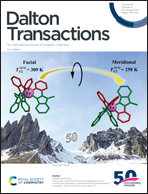A multi-binding site hydrazone-based chemosensor for Zn(ii) and Cd(ii): a new strategy for the detection of metal ions in aqueous media based on aggregation-induced emission†
Abstract
A multi-binding site chemosensor, N-(3-methoxy-2-hydroxybenzylidene)-3-hydroxy-2-naphthahydrazone (H3L), with excited-state intramolecular proton transfer (ESIPT) behaviour was prepared and characterized. It possesses no aggregation-induced emission (AIE) characteristics but can detect Cd2+ and Zn2+ ions selectively in the “off–on” mode based on the AIE of their complexes in the media of THF/HEPES and THF/H2O, respectively, which will provide a new strategy for target detection based on AIE. The detection limits of Zn2+ and Cd2+ were 9.85 × 10−9 M and 1.27 × 10−7 M, respectively. The aggregates of the complexes formed in the detection system were confirmed by DLS data and SEM images. The corresponding Zn2+ (1) and Cd2+ (2) complexes were prepared to investigate the response mechanism. Powder X-ray diffraction and single crystal X-ray diffraction proved that complex 1 is the species formed in the detection system. The chemosensor coordinates with the Cd2+ and Zn2+ ions in different formation and coordination modes, leading to the emission position of the aggregates at 560 and 645 nm, respectively, based on which Cd2+ ions were successfully differentiated from Zn2+ ions. Moreover, the detection of Cd2+ and Zn2+ ions was realized qualitatively via test paper and quantitatively in water.



 Please wait while we load your content...
Please wait while we load your content...